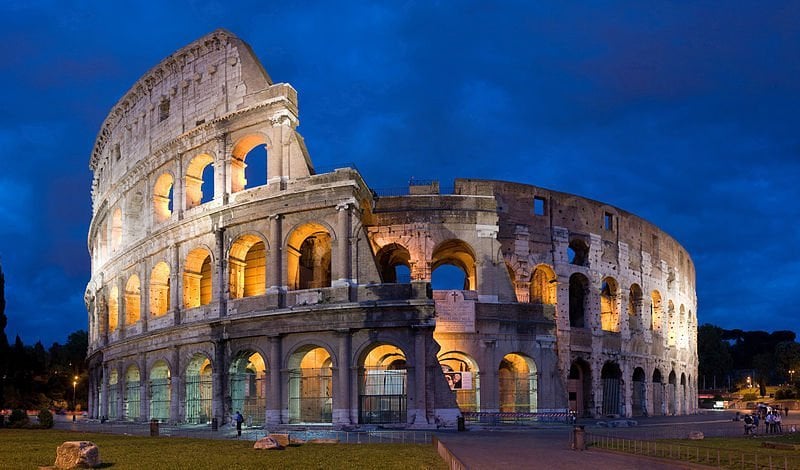Colosseum
The city's mythical monument is located at the very end of the Roman forum and can be reached in a mere 20 minutes walk from our hotel. This Roman amphitheatre is one of the most massive constructions of the Roman era. This iconic site is as stunning by day as it is lit up at night. Despite its demolished appearance due to successive earthquakes, looting and the use of its precious materials for the construction of St. Peter's Basilica, the site is very well preserved. This monument is an invitation to relive the history of Rome and its gladiators.
Discover our hotel ideally located near the Colosseum
Our property is ideally located for travellers who are looking for a hotel close to the Colosseum and to visit the city on foot. Discover this grandiose monument and avoid queuing by asking our staff for advice. Line-cut tickets are available, as are guided tours. The Colosseum is open every day from 8:30 a.m., with closing times depending on the season. Please contact us for more information or to book your room in Rome and enjoy our best available price.
The origins of the Colosseum
The Colosseum, also known as the Flavian Amphitheatre, is one of the most famous and emblematic buildings of Roman antiquity. Constructed in Rome between 70 and 80 AD, it was originally a stadium for public games and performances. The Colosseum is the largest amphitheater ever built and was used for a wide range of shows, including gladiatorial combat, chariot races and theatrical performances.
The Colosseum was built on the site of another building, Nero's Palace. This palace, built by Nero the Emperor in the middle of the 1st century AD, was his personal residence. However, after Nero's death, the palace was abandoned and eventually demolished to make way for the construction of the Colosseum.
Indeed, after the death of Nero, Emperor Vespasian decided to build the Colosseum to celebrate Rome's military victories and entertain the people. He therefore ordered the demolition of Nero's palace to make way for the construction of the Colosseum. Building materials from Nero's palace were reused to build the Colosseum, thus reducing construction costs. Vespasian restored to the Roman people this space in the heart of Rome's birthplace, a stone's throw from the Roman Forum.
Thus, the Colosseum became a symbol of the power and wealth of the Roman Empire, while Nero's palace became a mere historical anecdote. However, the destruction of Nero's palace to build the Colosseum shows Emperor Vespasian's determination to mark his reign and leave his mark on the city of Rome.
The Colosseum was able to accommodate up to 50,000 people and featured a system of marble tiers for spectators, a circular arena for the competitions and a system of tunnels for animals and gladiators taking part in the shows. The Colosseum was also equipped with an assemblage of wooden roofs that could be opened or closed according to weather conditions.
Public games were a key part of Rome's social and political life, and the Colosseum often hosted military victories and feasts. Spectators were frequently divided into different sections according to their social class allowing the wealthiest to enjoy reserved seats with an unobstructed view of the shows.
However, despite the Colosseum's political and cultural importance, public games were often criticized for their violence. Gladiatorial combat was often bloody, and wild animals were sometimes used to kill condemned criminals. As a result, many philosophers and intellectuals of the time criticized public games and their impact on Roman society.
Despite this criticism, public games continued to be held at the Colosseum until the 5th century AD, when the Roman Empire began to collapse. Over time, the Colosseum was abandoned and damaged by barbarian invasions, fires and earthquakes. However, efforts were made to restore the building, and today it is considered one of the most important monuments of Roman antiquity.
The Colosseum after the fall of the Roman Empire
The Colosseum has suffered much damage over the centuries. After the fall of the Roman Empire, it was plundered for its valuable building materials, while many elements were destroyed or damaged over time. However, despite the wreckage caused by barbarian invasions, earthquakes and fires, much of the Colosseum has been preserved and is still visible today.
Today, the Colosseum is considered a symbol of Rome's culture and history, attracting millions of visitors every year. As a UNESCO World Heritage Site, it is considered one of the most emblematic landmarks of Roman antiquity.
The Colosseum is an iconic tribute to the wealth and power of the Roman Empire.
To preserve the Colosseum for future generations, restoration and preservation efforts have been underway for several years. Restoration experts are working tirelessly to preserve the Roman masterpiece, using modern techniques to reinforce the foundations and stabilize the walls.
In addition, 3D scanning projects have been launched to create a virtual replica of the Colosseum, enabling researchers and historians to better understand how the building was constructed and how it evolved over time.
Finally, to raise awareness on the importance of preserving the Colosseum and its impact on the history and culture of Rome, education and outreach programs are in place to teach younger generations about the importance of this monument.
The Colosseum is therefore a living monument that evokes the rich and diverse history of Rome and continues to inspire people around the world. It remains a symbol of the culture and art of ancient Rome, and will continue to fascinate people for generations to come.


